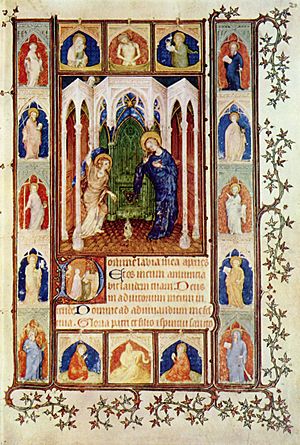Jacquemart de Hesdin facts for kids
Quick facts for kids
Jacquemart de Hesdin
|
|
|---|---|
| Born | c. 1335 |
| Died | c. 1414 |
| Nationality | French |
| Known for | Miniature Paintings |
| Style | International Gothic |
Jacquemart de Hesdin (around 1355 – about 1414) was a French artist. He was known for his beautiful miniature paintings, which are tiny, detailed pictures often found in books. He worked in a style called International Gothic, which was popular across Europe. Sometimes, he was also called Jacquemart of Hesdin.
Contents
Who Was Jacquemart de Hesdin?
Jacquemart was a painter from a region in France called Artois. He likely got his name from the town of Hesdin, which was a strong fortress in what is now Pas-de-Calais. This area was part of Flanders and controlled by the Duke of Burgundy. Jacquemart was one of many artists from the Netherlands who worked for the French royal family in the 1300s.
Working for the Duke of Berry
Jacquemart's main supporter was John, Duke of Berry (1340–1416). The Duke of Berry was a younger brother of King Charles V of France. He loved art and spent a lot of money collecting beautiful pieces. He was known for his excellent taste and for finding talented artists like Jacquemart de Hesdin and the Limbourg brothers.
The Duke of Berry and his brothers helped rule France for a while when King Charles VI was too young or unwell. Even though the Duke spent huge amounts on his art, he helped new art styles develop during his time. Jacquemart was considered a friend and a special artist to the Duke.
Jacquemart's Art Career
Jacquemart spent his entire career working at the Duke of Berry's court in Bourges, the capital of the Province of Berry. He worked for the Duke from 1384 until 1414. He played a very important role in creating the Duke's famous illuminated books. These were handwritten books with amazing painted decorations.
Famous Books He Worked On
Jacquemart helped create several well-known books, including:
- The Très Belles Heures du Duc de Berry (meaning "Very Beautiful Hours of the Duke of Berry")
- The Grandes Heures ("Great Hours")
- The Petites Heures ("Small Hours")
- A Psalter (a book of psalms)
He often worked with other famous artists, such as the Limbourg brothers and the painter known as the Boucicaut Master.
Life at Court
Jacquemart received his first payment from the Duke of Berry's staff on November 28, 1384. This payment covered his and his wife's living costs in Bourges, and he also received money for his winter clothes. After this, he was paid a regular salary.
In 1398, while working for the Duke in a castle in Poitiers, Jacquemart and his assistant were accused of taking art supplies from another painter. He was recorded as staying in Bourges in 1399.
The Très Belles Heures
The Très Belles Heures du Duc de Berry is mostly Jacquemart's work. This book is sometimes called the Brussels Hours because it has been kept in Brussels for a long time. An old list of the Duke's books from 1402 describes it as: "Very beautiful hours richly lit up and illustrated by the hand of Jacquemart de Odin."
This book disappeared for hundreds of years. However, experts now agree that the manuscript found in the Bibliothèque Royale (Royal Library) in Brussels is the same one described in the 1402 list.
The Petites Heures
Jacquemart and other artists were given the job of finishing the Petites Heures in 1384. This book had been started by another artist named Jean Le Noir. Some experts believe that at least five painters worked on the pictures in this book, including Jacquemart and four artists whose names we don't know. One of these unknown artists is often called the Pseudo-Jacquemart.
Jacquemart's small painting called The Carrying of the Cross is now in the Musée du Louvre in Paris. It was painted before 1409.
Jacquemart's Artistic Style

Jacquemart was very skilled at showing space in his paintings. This means he could make things look like they had depth, almost like a 3D picture. He learned a lot from artists from Siena, a city in Italy.
He also showed new trends from northern Europe, which focused on making things look more natural and real. This was different from the more perfect and idealized art of artists like Jean Pucelle.
Jacquemart was influenced by Italian painting, especially from Siena. His work often included detailed architectural interiors. These interiors helped place the figures in his paintings in a way that felt real and believable. By studying the work of Pucelle and Italian painters, Jacquemart improved how he shaped figures and created space. He also changed the realistic style that was common among painters from the Netherlands during that time.
He was also known for his marginalia. These were decorative shapes of animals and plants that he used to create beautiful frames around the pages of his manuscripts.
See also
 In Spanish: Jacquemart de Hesdin para niños
In Spanish: Jacquemart de Hesdin para niños

